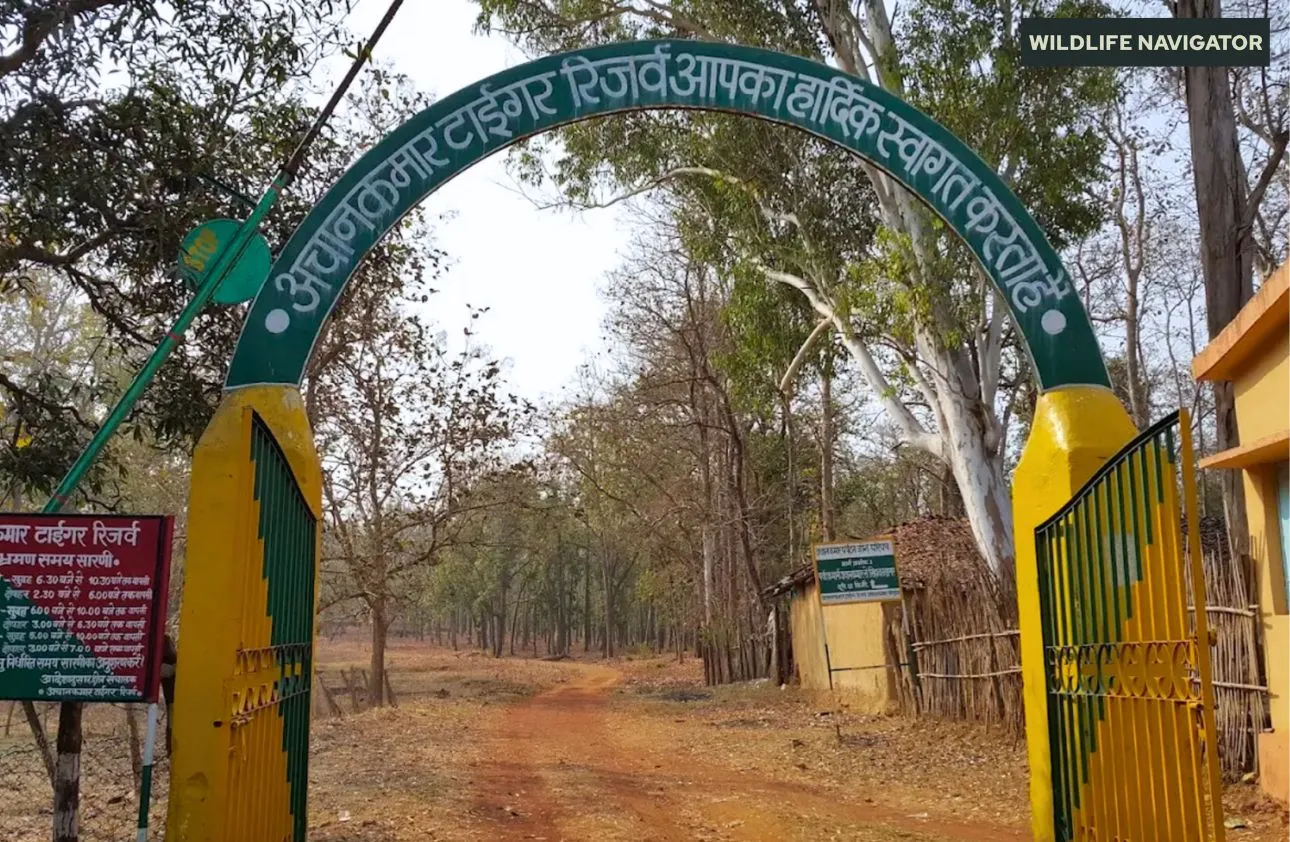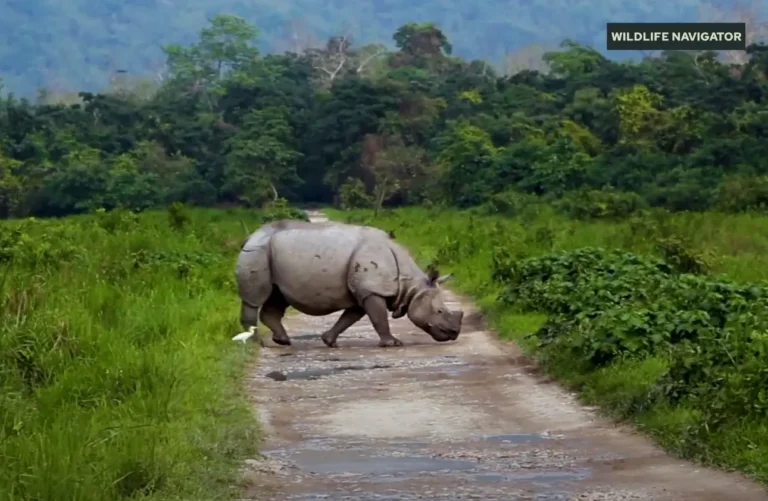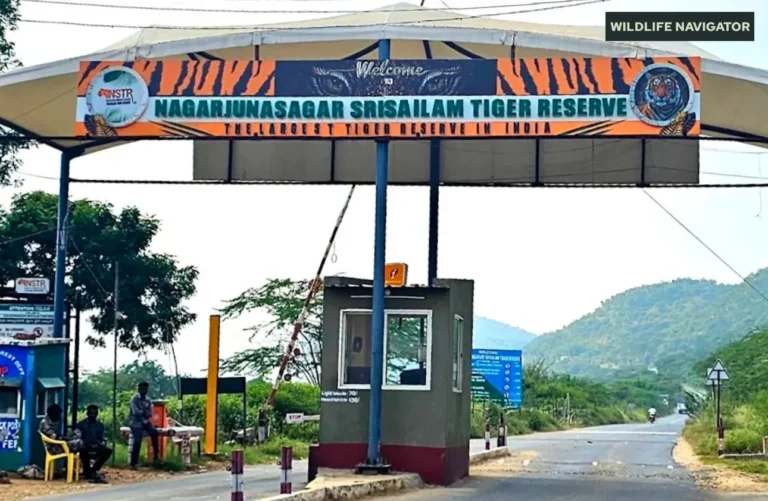Achanakmar Tiger Reserve– Wildlife Encounters in the Heart of India

Achanakmar Tiger Reserve is one of India’s most enchanting yet lesser-explored wilderness destinations. Spread across dense sal and bamboo forests, rolling hills, and sparkling streams, the reserve is part of the larger Achanakmar–Amarkantak Biosphere Reserve, which is also a source region of several important rivers. Declared a Tiger Reserve in 2009 under Project Tiger, it has since gained recognition as a critical stronghold for wildlife conservation in central India.
What sets Achanakmar apart is its combination of raw natural beauty and rich biodiversity. Home to majestic predators like tigers and leopards, along with gaur (Indian bison), sloth bears, and an incredible variety of birds, the reserve offers a true wilderness experience away from commercial crowds. Its remote location makes it a perfect retreat for nature lovers, wildlife photographers, and eco-travellers who seek serenity and adventure in equal measure.
Beyond its wildlife, Achanakmar also holds cultural and ecological importance. Surrounded by tribal villages and blessed with unique flora, it reflects the deep bond between local communities and the forest. For travellers looking to explore tiger reserves in India that are both wild and soulful, Achanakmar stands as an unforgettable destination.
History, Geography, and Landscape of Achanakmar Tiger Reserve
Historical Background
Achanakmar was first declared a wildlife sanctuary in 1975, covering an area of over 550 sq km. Recognising its ecological richness and the presence of tigers, it was brought under the prestigious Project Tiger network in 2009, officially becoming a Tiger Reserve. This step marked a milestone in strengthening tiger conservation in central India.
The reserve is also part of the larger Achanakmar–Amarkantak Biosphere Reserve, which is a UNESCO-recognised site due to its unique ecosystems. Its strategic location not only safeguards a thriving population of wildlife but also protects the origin of important rivers that flow into central and eastern India.
Geographical Location
Achanakmar Tiger Reserve is located in the Bilaspur and Mungeli districts of Chhattisgarh. Sprawled across 914 square kilometres, the reserve lies within the Maikal Hill ranges, which form the eastern extension of the Satpura hills. It is bordered by dense forests, valleys, and hills, creating a breathtaking natural setting for both wildlife and visitors.
The reserve also shares ecological continuity with Madhya Pradesh, making it part of a vital wildlife corridor for tigers, leopards, and other species.
Terrain and Landscape
The landscape of Achanakmar is a mix of steep hills, deep valleys, and dense forests. About 63% of the area is covered in sal forests, with bamboo and other hardwood species scattered across the terrain. Small rivers and perennial streams crisscross the forest, ensuring water availability for animals throughout the year.
The altitude varies from 200 to 1,000 meters above sea level, giving rise to diverse habitats within the reserve. This variation supports everything from thick tropical forests to grasslands, making Achanakmar a true biodiversity hotspot.
Climate and Weather
Achanakmar experiences a tropical climate, with hot summers, heavy monsoon rains, and cool winters.
- Summer (March–June): Temperatures can soar above 40°C, but wildlife sightings are frequent near water sources.
- Monsoon (July–September): The forest turns lush green, though safaris may be restricted due to heavy rains.
- Winter (October–February): The best season to visit, with pleasant weather (10–25°C) and excellent wildlife spotting opportunities.
Flora and Fauna of Achanakmar Tiger Reserve
Rich Flora
The forests of Achanakmar are predominantly tropical moist deciduous, dominated by sal trees, which cover a majority of the landscape. Along with sal, several other species create a dense green canopy, offering food and shelter to wildlife.
Major Tree Species
- Sal (Shorea robusta)
- Teak (Tectona grandis)
- Saja (Terminalia tomentosa)
- Mahua (Madhuca indica)
- Bija (Pterocarpus marsupium)
- Bamboo (Dendrocalamus strictus)
Medicinal and Useful Plants
- Harra (Terminalia chebula) – valued in Ayurveda
- Amla (Phyllanthus emblica) – rich in Vitamin C
- Tendu leaves – traditionally used for making bidis (local cigarettes)
- Tamarind, jamun, and other fruit-bearing trees that sustain wildlife and local communities
During the monsoon season, the forest floor bursts into life with wildflowers, ferns, and mushrooms, turning Achanakmar into a vibrant green paradise.
Diverse Fauna
Achanakmar is home to an impressive variety of animals, earning its place among the important tiger reserves in India. From apex predators to shy herbivores and colourful birdlife, the reserve is a sanctuary for countless species.
Mammals
- Bengal Tiger
- Leopard
- Indian Gaur (Bison)
- Sloth Bear
- Wild Dog (Dhole)
- Sambhar Deer
- Chital (Spotted Deer)
- Four-horned Antelope (Chousingha)
- Wild Boar
Birds
The reserve is a birdwatcher’s delight, with over 150 species of resident and migratory birds, including:
- Indian Peafowl
- Red Junglefowl
- Hornbills
- Parakeets
- Crested Serpent Eagle
- Lesser Adjutant Stork
- Paradise Flycatcher
Reptiles and Amphibians
- Indian Rock Python
- Cobra
- Monitor Lizard
- Star Tortoise
- Various species of frogs and toads during the monsoon
Aquatic Life
Rivers and streams inside the reserve also sustain freshwater species like small fish, turtles, and crabs, ensuring a complete ecological balance.
Safari Experience at Achanakmar Tiger Reserve
A safari at Achanakmar is one of the best ways to explore the dense forests, observe wildlife in their natural habitat, and experience the true charm of wilderness. The reserve offers jeep safaris that take visitors deep into the forest trails, where every turn holds the promise of spotting something spectacular.
Types of Safari
Currently, jeep safari is the primary mode of exploration inside the Achanakmar Tiger Reserve. These safaris are guided by trained drivers and naturalists who are well-versed with the terrain and wildlife behaviour.
- Morning Safari: Offers the best chance of spotting tigers, leopards, and other predators as they are most active during dawn.
- Evening Safari: Ideal for birdwatching, herbivore sightings, and experiencing the magical sunset views over the forest.
Popular Safari Routes
The safari routes are designed to cover different landscapes of the reserve – from sal forests to grasslands and riverine patches. Some of the well-known routes include:
- Lormi Gate Route: Known for tiger and leopard sightings
- Keonchi–Lamni Route: Rich in birdlife and dense forests
- Amarkantak Buffer Route: Offers scenic landscapes and glimpses of tribal settlements
Each route provides a unique experience, making multiple safaris worthwhile.
Best Wildlife Sightings
During safaris, visitors may encounter a wide range of animals, including:
- Predators: Tiger, leopard, wild dog
- Herbivores: Gaur, sambhar, chital, barking deer
- Birds: Peafowl, hornbills, crested serpent eagle
- Reptiles: Monitor lizards and snakes basking on rocks or trails
Safari Timings and Duration
The safari timings vary slightly with the season but generally follow:
- Morning Safari: 6:00 AM – 10:00 AM
- Evening Safari: 2:30 PM – 6:00 PM
Each safari lasts around 3–4 hours, offering ample time to cover different terrains.
Photography Opportunities
Achanakmar is a paradise for wildlife photographers.
- Golden Hours: Early mornings and late afternoons are perfect for capturing animals in soft light.
- Birding Shots: Carry a zoom lens (300mm or above) for detailed shots of hornbills and other birds.
- Landscape Frames: Wide-angle shots are best for capturing sal forests and misty hills in winter.
Safari Booking and Permits
- Entry permits are required for all safaris, which can be booked at the official gates.
- A limited number of vehicles are allowed per day to minimise human disturbance.
- Visitors must carry valid ID proof while entering the reserve.
Best Time to Visit Achanakmar Tiger Reserve
Achanakmar Tiger Reserve is open to visitors for most of the year, but the overall experience varies with the changing seasons. From summer’s dry landscapes to the lush greenery of monsoon and the pleasant winters, each season offers a different charm for travellers.
Summer (March – June)
- Temperature: 30°C – 42°C
- Highlights:
- Best time for spotting tigers, leopards, and other animals near water sources.
- Clear visibility on safari routes.
- Travel Tip: Carry light cotton clothes, sunscreen, caps, and plenty of water. Morning safaris are more comfortable than afternoon ones.
Monsoon (July – September)
- Temperature: 22°C – 30°C
- Highlights:
- The forest transforms into a lush green paradise.
- Streams and waterfalls flow in full force, offering scenic beauty.
- Travel Tip: Safaris may be restricted due to heavy rains and slippery roads. This season is better for nature lovers and photographers than for wildlife spotting.
Winter (October – February)
- Temperature: 8°C – 25°C
- Highlights:
- Pleasant climate makes safaris more enjoyable.
- Best season for birdwatching as many migratory species arrive.
- Morning mist adds a magical charm to the sal forests.
- Travel Tip: Carry warm clothing for early morning safaris. This is the most recommended season to visit.
Ideal Months to Visit
- October to March is considered the best time to explore Achanakmar Tiger Reserve.
- Wildlife sightings are good, the weather is comfortable, and the overall safari experience is at its peak.
How to Reach Achanakmar Tiger Reserve
Reaching Achanakmar is convenient as it is well-connected by air, rail, and road. The reserve lies in the Bilaspur and Mungeli districts of Chhattisgarh, and visitors can choose the best option depending on their location and travel preferences.
By Air
- Nearest Airport: Swami Vivekananda Airport, Raipur (approx. 180 km from Bilaspur)
- From Raipur, tourists can hire taxis or take buses to Bilaspur, and then continue towards Achanakmar.
- Other nearby airports: Jabalpur (Madhya Pradesh) and Nagpur (Maharashtra), though Raipur is the most convenient.
By Rail
- Nearest Railway Station: Bilaspur Junction (about 55 km from the reserve)
- Bilaspur is well-connected with major Indian cities like Delhi, Kolkata, Mumbai, and Nagpur.
- From the station, taxis and buses are available to reach the reserve gates.
By Road
- Achanakmar is accessible by a network of state highways and local roads.
- Distance from major cities:
- Bilaspur – 55 km
- Amarkantak – 50 km
- Raipur – 180 km
- Private cars, hired taxis, and state transport buses are commonly used for road travel.
Entry Gates
The reserve has multiple entry gates, the most popular being:
- Lormi Gate (near Bilaspur)
- Keonchi Gate (close to Amarkantak)
Both gates provide access to different safari routes, giving visitors options depending on their travel itinerary.
Travel Tip
- Road journeys offer scenic drives through forests and tribal villages, enhancing the experience even before entering the reserve.
- If you’re short on time, Raipur → Bilaspur (train/road) → Achanakmar is the fastest and most reliable route.
Accommodation Options at Achanakmar Tiger Reserve
Staying close to the forest enhances the overall safari experience, and Achanakmar Tiger Reserve offers a range of accommodation options for different budgets and preferences. From government-run forest rest houses to eco-tourism lodges and nearby hotels, visitors have several choices.
Forest Rest Houses (Inside/Adjacent to Reserve)
The Forest Department manages a few rest houses that allow travellers to stay close to nature.
- Lamni Forest Rest House – Located within the reserve, it offers basic facilities and the thrill of staying inside the forest. Wildlife enthusiasts often prefer it for its proximity to safari routes.
- Achanakmar Forest Rest House – Another option managed by the Forest Department, ideal for travellers looking for rustic, quiet stays.
Facilities:
- Rooms with basic bedding and furniture
- Attached bathrooms (limited modern amenities)
- Meals usually arranged through caretakers or on prior request
- Limited electricity (sometimes generators/solar)
Best For: Hardcore nature lovers and photographers who want to experience the raw jungle atmosphere.
Eco-Tourism Lodges & Homestays
In recent years, eco-tourism has grown around Achanakmar, with simple lodges and tribal homestays available in nearby villages.
- Lamni Eco-Cottages – Built to promote eco-tourism, they provide a sustainable stay option.
- Community Homestays – Run by local tribal families, offering cultural experiences with authentic food, traditional art, and folk music.
Facilities:
- Comfortable rooms or cottages with clean bedding
- Local meals prepared with fresh produce
- Guided walks around villages and forest fringes
- Opportunities to learn about tribal culture and traditions
Best For: Travellers seeking authentic experiences, cultural interaction, and budget-friendly stays.
Hotels and Resorts Near Achanakmar
If you prefer more comfort and amenities, there are hotels and resorts available in Bilaspur (about 55 km away) and Amarkantak (50 km away).
In Bilaspur:
- Mid-range and budget hotels suitable for families and groups
- Restaurants with varied cuisines
- Convenient if you want to combine wildlife and city exploration
In Amarkantak:
- Resorts and hotels with scenic views of the Maikal Hills
- Ideal for combining spiritual tourism (Amarkantak temples) with a wildlife experience
- More relaxing atmosphere compared to Bilaspur’s bustle
Things to Keep in Mind
- Advance Booking: Forest rest houses and eco-lodges have limited rooms. Booking in advance, especially during winter season (Oct–Feb), is recommended.
- Connectivity: Mobile network coverage inside the reserve is patchy, so be prepared for digital detox.
- Food Arrangements: Carry snacks and bottled water. Meals inside rest houses and homestays are usually simple but fresh and wholesome.
- Eco-Friendly Stay: Avoid plastic, respect local culture, and follow eco-tourism guidelines to support conservation efforts.
Local Culture and Attractions Around Achanakmar Tiger Reserve
A visit to Achanakmar is not just about safaris—it’s also an opportunity to experience the rich tribal culture of Chhattisgarh and explore nearby natural and spiritual attractions. This combination makes the trip unique, blending wildlife adventure with cultural discovery.
Tribal Communities and Traditions
The region around Achanakmar is inhabited by several indigenous tribal communities such as the Baiga, Gond, and Kanwar tribes. Their close relationship with the forest is reflected in their daily life, art, and traditions.
Cultural Highlights:
- Traditional Homes: Made of mud and bamboo with thatched roofs, blending harmoniously with the forest environment.
- Folk Music and Dance: Performed during festivals and community gatherings, using local instruments like madar and dhol.
- Handicrafts and Art: Bamboo work, tribal jewellery, and vibrant paintings often depict wildlife and nature.
- Food Culture: Simple yet healthy meals, often cooked with forest produce like mahua flowers, mushrooms, and wild herbs.
Visitors staying in community homestays can witness or even participate in cultural programs, making the journey more meaningful.
Nearby Attractions
1. Amarkantak (50 km)
- A sacred hill town, also known as the “Teerthraj” (King of Pilgrimage).
- Source of the Narmada, Son, and Johilla rivers.
- Famous for temples like Narmada Udgam Mandir and natural spots like Kapildhara Waterfalls.
- Offers a serene combination of spirituality and natural beauty.
2. Kabir Chabutra (near Amarkantak)
- A historic spot associated with the 15th-century saint-poet Kabir Das, believed to be where he meditated.
- A peaceful destination with spiritual significance.
3. Waterfalls Around the Region
- Kapildhara Waterfall: Cascading through lush greenery, just 8 km from Amarkantak.
- Dudh Dhara Waterfall: Known for its milky white water, located close to Kapildhara.
- Shahdol Forest Streams: Lesser-known spots where small streams create hidden cascades.
4. Local Markets and Villages
- Weekly tribal markets (haats) are colourful affairs where locals sell forest produce, handmade crafts, and traditional snacks.
- Great place to interact with locals and understand their way of life.
Why Cultural Exploration Matters
Exploring beyond safaris adds depth to your journey. By interacting with tribal communities and visiting nearby attractions:
- You contribute to eco-tourism and local livelihoods.
- You gain a holistic experience of both nature and culture.
- You carry memories not only of wildlife sightings but also of human connections and cultural heritage.
Conservation Efforts and Challenges at Achanakmar Tiger Reserve
Achanakmar Tiger Reserve is not only a wildlife sanctuary but also a key hub for conservation in central India. Protecting its rich biodiversity, especially the Bengal tiger population, requires ongoing efforts from both the Forest Department and local communities.
Project Tiger and Wildlife Protection
- Inclusion under Project Tiger (2009): Achanakmar became part of India’s flagship tiger conservation program to ensure the survival of tigers and their prey.
- Anti-Poaching Measures: Regular patrolling, camera traps, and intelligence networks help prevent poaching of tigers, leopards, and other endangered species.
- Wildlife Monitoring: GPS tracking and wildlife census programs are conducted to monitor tiger populations and the movement of other key species.
Community Involvement
The local tribal communities play an essential role in conservation efforts:
- Eco-Guard Programs: Tribal youth are trained as forest guides and eco-guards, providing employment while safeguarding wildlife.
- Awareness Campaigns: Villagers are educated on the importance of protecting forests and wildlife to prevent human-wildlife conflicts.
- Sustainable Livelihoods: Eco-tourism and handicraft programs help reduce dependency on forest exploitation.
Habitat Management
- Forest Restoration: Afforestation and maintenance of grasslands ensure adequate prey for tigers and other carnivores.
- Water Resource Management: Streams, ponds, and waterholes are maintained to sustain wildlife, especially during dry seasons.
- Corridor Protection: The reserve forms part of a larger wildlife corridor connecting Madhya Pradesh and Chhattisgarh forests, ensuring genetic diversity and safe tiger movement.
Challenges Facing Achanakmar
Despite these efforts, several challenges persist:
- Human-Wildlife Conflict: Crop raiding by herbivores and occasional predator attacks on livestock can strain community relations.
- Poaching and Illegal Trade: Tigers, leopards, and other species remain at risk from illegal wildlife trade.
- Habitat Loss and Fragmentation: Encroachment, mining, and infrastructure development threaten forest continuity.
- Tourism Pressure: Unregulated tourism could disturb wildlife if proper guidelines are not followed.
Ongoing Initiatives
- Eco-friendly tourism policies to minimise disturbance.
- Collaborations with NGOs and research institutions for biodiversity monitoring.
- Community-driven forest patrols and awareness campaigns to ensure long-term conservation.
Through coordinated efforts between the Forest Department and local communities, Achanakmar Tiger Reserve continues to be a stronghold for tigers while balancing conservation with sustainable tourism.
Travel Tips for Visitors to Achanakmar Tiger Reserve
A visit to Achanakmar Tiger Reserve can be a once-in-a-lifetime experience if planned well. From safari bookings to safety measures, following these tips ensures a smooth, enjoyable, and responsible trip.
Entry Permits and Safari Booking
- Mandatory Permits: All visitors must obtain an entry permit before entering the reserve.
- Booking: Safaris can be booked at the reserve gates or online (depending on availability). It’s advisable to book in advance during peak season (October–February).
- Guides: Hire a trained forest guide or naturalist to enhance your safari experience—they can help spot wildlife and provide insights about the forest.
What to Carry
- Clothing: Light cotton clothes for summer, rain gear for monsoon, and warm layers for winter mornings.
- Footwear: Comfortable walking shoes or boots for rough terrain.
- Photography Gear: DSLR or mirrorless camera with telephoto lens for wildlife shots; wide-angle lens for landscapes.
- Essentials: Sunglasses, sunscreen, insect repellent, water bottles, snacks, binoculars, and a hat.
Do’s and Don’ts Inside the Reserve
Do’s:
- Follow all rules and instructions from forest staff.
- Maintain silence during safaris to avoid disturbing wildlife.
- Respect tribal communities and local customs in nearby villages.
- Carry a notebook or camera to document wildlife sightings responsibly.
Don’ts:
- Do not litter; carry all trash back with you.
- Avoid feeding wildlife—human food can harm animals.
- Do not venture outside designated safari routes or forest paths.
- Avoid loud noises, flash photography, or sudden movements near animals.
Safety and Health Tips
- Carry a basic first-aid kit for minor injuries or insect bites.
- Drink only bottled or purified water.
- Be cautious of snakes and insects while walking near forest trails.
- Inform the forest staff if you have any medical conditions or an emergency.
Best Practices for Responsible Tourism
- Support eco-friendly accommodations and local tribal homestays.
- Respect flora and fauna—do not pluck plants or disturb habitats.
- Use sustainable transportation options like shared jeeps whenever possible.
- Educate yourself about wildlife conservation efforts to appreciate the reserve more deeply.
By following these tips, visitors can enjoy a safe, immersive, and responsible wildlife experience while contributing to the protection of Achanakmar’s biodiversity.
Conclusion
A visit to Achanakmar Tiger Reserve is more than just a safari—it is an immersive journey into one of India’s richest wildlife habitats. From dense sal and bamboo forests to majestic tigers, elusive leopards, and vibrant birdlife, the reserve offers a true wilderness experience. Coupled with the cultural richness of nearby tribal communities and attractions like Amarkantak, travellers get a blend of adventure, nature, and heritage.
Whether you are a wildlife enthusiast, a nature photographer, or someone seeking peace amidst verdant landscapes, Achanakmar promises an unforgettable experience. By supporting eco-tourism and following responsible travel practices, visitors not only enjoy the reserve but also contribute to its long-term conservation.
For anyone exploring tiger reserves in India, Achanakmar stands out as a hidden gem—less commercialised yet teeming with biodiversity, serenity, and adventure.
FAQs About Achanakmar Tiger Reserve
1. Is Achanakmar open throughout the year?
The reserve is open most of the year, but safaris are best between October and February. Monsoon months (July–September) may have restricted access due to heavy rains.
2. How many tigers are in Achanakmar Tiger Reserve?
Tiger populations vary, but the reserve hosts a healthy tiger population monitored under Project Tiger. Sightings are possible during morning and evening safaris.
3. Can tourists stay inside the reserve?
Yes, visitors can stay in forest rest houses, eco-lodges, or tribal homestays near the reserve. Advanced booking is recommended, especially in winter.
4. Are safaris safe for families with children?
Absolutely! Safaris are conducted in guided jeeps, and forest staff ensures safety. Children should be supervised and follow safari rules.
5. What is the best way to reach Achanakmar?
The most convenient route is via Bilaspur (railway) or Raipur (airport), followed by road travel to the reserve gates.
6. Do I need a permit for visiting Achanakmar?
Yes, all visitors require an entry permit, which can be obtained at the gates or sometimes booked online in advance.
7. Are there opportunities for photography and birdwatching?
Yes, the reserve is ideal for wildlife photography and birdwatching, with over 150 species of birds and a variety of mammals and reptiles.





